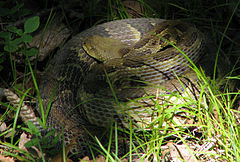Crotalus horridus: Difference between revisions
imported>Peter Lacey m (Crotalus horridus moved to Crotalus horridus ON WHEELSS!!!: Long Live Wikipedia!) |
imported>Chris day m (Crotalus horridus ON WHEELSS!!! moved to Crotalus horridus: revert) |
Revision as of 11:27, 16 February 2007
| Crotalus horridus | ||||||||||||||||||||||
|---|---|---|---|---|---|---|---|---|---|---|---|---|---|---|---|---|---|---|---|---|---|---|
 Timber rattlesnake, Crotalus h. horridus
| ||||||||||||||||||||||
| Conservation status | ||||||||||||||||||||||
| Scientific classification | ||||||||||||||||||||||
| ||||||||||||||||||||||
| Trinomial name | ||||||||||||||||||||||
| Crotalus horridus Linnaeus, 1758 |
Crotalus horridus is a venomous rattlesnake species commonly known as the timber rattlesnake. Besides the nomiotype, C. h. horridus, described here, there is one other subspecies. Both are found in the Eastern United States.
Description
C. horridus usually measures between 3 feet to 4' 6" long. Their prey is mainly small mammals, but may include birds, frogs, or other snakes. Research cataloging the stomach contents of museum specimens indicates that this species has a very strong preference for small mammals even when young. "Small timber rattlesnakes prey mostly on very small mammals, such as shrews (Sorex spp.), white-footed mice (Peromyscus) and house mice (Mus muscus). In contrast to snake species that eliminate smaller items from their diet as they grow, timber rattlesnakes continue to consume these species as adults. However, as they grow, their diet does expand to include larger items, such as chipmunks (Tamias striatus), cotton rats (Sigmodon hispidus), squirrels (Sciurusspp.), and rabbits (Sylvilagus spp.)." [1]
Like all rattlesnakes, C. horridus can be identified by the distinctive rattle at the end of the tail. Color patterns vary but all have dark, thick and wavy crossbands or stripes. A small hole or "pit", which is a sensory organ unique to all pit vipers, can be seen on each side of the head between the eyes and the nostrils (for more information, see pit viper).
The timber rattlesnake was featured prominently in the American Revolution, specifically as the symbol of the first Continental Navy in the First Navy Jack.
Range
Their current range spans from southern Wisconsin to Texas, and east toward the coastline, from Georgia to parts of New Hampshire and northern New York. Its habitat is generally forests and rugged terrain where it is cooler and damper.
Venom
C. horridus venom is less potent than that of its more dangerous cousins, notably C. adamanteus and C. atrox. Though generally not lethal, swelling and tissue damage may occur from a bite. Like all other venomous snakes, it can control the amount of venom that is delivered; as a result, not all reported timber rattlesnake bites state venom was injected into the victim.
Conservation status
The conservation status of the species is listed as threatened or endangered in 18 states. It is endangered in Indiana, New Jersey and Ohio; threatened in Illinois and Minnesota; protected in Wisconsin.
Numbers declined largely due to a history of bounty hunting and collecting (in the past). Today, loss of habitat is the primary concern over declining populations in several states protecting the species.
Environmentalists in the New Jersey Pinelands have fought development in rattlesnake sanctuaries. A controversy over timber rattlesnakes in Evesham Township, NJ, was the inspiration for the 2006 novel, "Rattled," by Debra Galant (St. Martin's Press).
Subspecies
| Subspecies | Authority | Common name | Geographic range |
|---|---|---|---|
| C. h. horridus | Linnaeus, 1758 | Timber rattlesnake | North-Eastern United States |
| C. h. atricaudatus | Latreille, 1802 | Canebrake rattlesnake | South-Eastern United States |
See also
References
- ↑ Rulon W. Clark, Diet of the Timber Rattlesnake, Crotalus horridus.Journal of Herpetology, Volume 36, Issue 3 (September 2002) pp. 494–499
External links
- NY State Dept. of Environmental Conservation
- Herp Center - http://herpcenter.ipfw.edu/outreach/accounts/reptiles/snakes/Timber_Rattlesnake/index.htm&2
- EMBL Reptile Database
- EMBL Reptile Database - Family Viperidae
- Species Crotalus horridus at the Species2000 Database